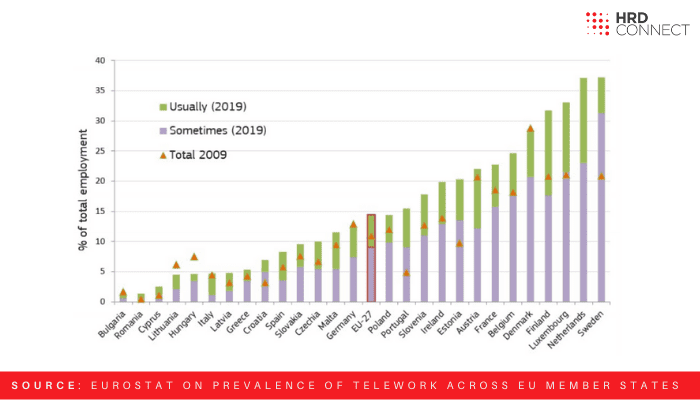The Long Read: How to build a successful, remote-first company culture
- 21 Min Read
At HRD Connect, our aim is to provide invaluable insights and exclusive interviews examining the most innovative practices that help HR and business leaders meet the challenges they face – from the importance of analytics to the rise of remote working.
- Author: Yinka Opaneye
- Date published: Nov 9, 2020
- Categories

In our new series of long reads, we examine some of the most pressing issues of the day with additional depth: assessing the importance, interrogating the causes, and proposing the solutions, drawing on expert opinions and extensive research. Our inaugural feature is on a topic close to the heart of businesses and employees today: how to build a successful remote-first company culture.
Analyzing this trend is Yinka Opaneye, the Global HR Director for GameAnalytics, one of the industry’s most popular analytics tools, and works with other brands under the aegis of mobile advertising company Mobvista.
Coronavirus and the origins of remote working
The Coronavirus pandemic has created a level of disruption which hasn’t been seen for many years. It is personally and professionally uncomfortable; people have been made to scrap their plans, limit their movements, worry for their careers, and much more. Businesses have been forced to transform their operations, drastically revise their forecasts, and work to build remote-first company cultures.
Currently, it is the HR/people operations function that has seemed best suited to navigate organizations through this difficult time. However, over the course of months, many have discovered the benefits of working-from-home and a porous working schedule, which is the ability to mix both work and non-work activities through the day e.g. having mid-workday personal appointments or working flexible hours. In fact, many firms have wondered: do we really need the office?
Remote working (previously called teleworking) is not a new or unheard-of concept. Prior to the pandemic, it was already routinely applied within several roles and fields. It had gained some popularity in highly sought-after technology roles and on freelancing platforms like fiverr, Upwork and PeoplePerHour. That said, the practice received criticism for being precarious and subject to exploitation.
However, remote working is now becoming mainstream. According to PWC, pre-Coronavirus, 67 percent of employees worked less than one day a week remotely; now 72 percent have registered an interest and intent of working more than three days away from the office, even after the pandemic is over.
Irrespective of whether a firm chooses to remain fully office-based, pivots to being fully remote, or chooses to use a hybrid model, employees will be looking at this organizational structure with greater interest. Of course, not all jobs may be performed remotely. It is more suited to “knowledge roles,” those positions which rely more on the jobholders’ thinking, rather than physical labor or movement.
These are roles primarily comprising researching, working with data, writing, and communicating without a physical presence necessary. If demanded, it is crucial that HR clearly assess how to make remote working a success for the business.
Contextual challenges to remote-first company cultures?
Similarly, not everywhere is equally ready for remote working. The HBR published an article on the “social distance readiness” of nation-states, evaluating their robust digital platforms, internet speeds, and the expense of having high-speed internet. It largely separated countries along a wealth divide. Remote working appears to be an option for the wealthy.
Additionally, some cultures might be more suited to remote working than others, a factor which is often not considered. Though old and seldom cited, due to the lack of empirical research, is the work by anthropologist Edward T. Hall looking at low and high-context cultures. The concept evaluates how much value nations place on various aspects of communication, whether explicit or implicit, written or spoken and planned/orderly, or flexible to change.
With remote working, where more written content is expected and more planning required for meetings or face-to-face gatherings is necessary and less emphasis is placed on talking, low context cultures appear to be less likely to thrive or promote the concept of remote working.
Little research has been conducted matching high-low context cultures and their propensity to take on remote working, but there is some evidence to support this notion. In a report by the European Commission, Telework in the EU, before and after COVID-19, it’s clear to see that European countries with low-context cultures were more likely to have embraced remote working pre-Coronavirus.

Countries in Northern Europe and Scandinavia are low-context cultures, whilst those in Southern Europe and the Slavic nations are more high-context ones. This is not to say that remote working is impossible in high-context states, but it might face fewer issues of implementations in nation-states with low-context cultures.
It might also, as is the case with Germany in the graph above, demonstrate potential, all things being equal, of where remote working might be particularly welcomed. For added complexity, a firm’s internal culture does not necessarily match the low-high context culture of the wider national culture within which it exists.
Are some organizations more suited to being remote?
Looking more deeply into organizational culture, it’s important to know: are some organizational cultures more suited to working remotely? There are several ways to analyze a company’s culture, but two elements of importance include contextual context and the level of trust. The former deals with the level of understanding which the workforce has about what is happening in the business.
It is directly related to feelings of loneliness and isolation, both of which have increased during the lockdown as firms have had to adopt remote working structures. A culture with time-poor leaders unable to articulate the strategic direction risks exacerbating loneliness. Whilst an administrative team or organizational culture which does not provide access can cause isolation, creating unnecessary complexities for employees.
Prior to the lockdown, the biggest obstacle for remote working was whether productivity would suffer as a result of employees losing focus and completing fewer tasks. Specifically, how much trust employers and managers had in their team working to the best of their abilities. Another aspect of this lack of trust is in employees sometimes overworking and under increasing pressure to ‘display’ that they are working. This is clearly a dangerous mindset, as prolonged periods of overworking can and often does lead to burnout. However, there are other adverse effects on people’s emotions.
A study by the UK Office of National Statistics (ONS) found that anxiety levels which had peaked at the start of the lockdown (5.7), have reduced as lockdown restrictions were eased (3.7). However, it’s still much higher than pre-Coronavirus (Q4 2019) which stood at 2.97. Another study by UCL looking at the mental well-being of over 90,000 UK adults found a strong correlation between worsening mental health and lockdown. This decrease in mental wellbeing (particularly sustained periods of stress) has been shown to lead to increased levels of high blood pressure, diabetes and heart disease.

Creating a remote-first company culture
Even with these pressures and potential pitfalls, companies are now being forced to think ‘flexibility.’ Whether that is how many people may work in the office safely, whilst practicing social distancing, or whether it is coming up with new ways of managing the remote structure. Either way, remote working will remain with companies in some shape or form for a while. This begs the second question: how do we create a remote-first company culture, with each function performing to its best?
A company deciding to remake itself into a remote-first company culture must do so deliberately. Failing to consider what to change and presuming that it will occur naturally when employees are simply given the option, will cause distress and strain, especially for the most junior and the newest employees, the HR and Admin teams and team leads.
However, even with all these considerations, it’s impossible to deny the growth in interest in remote working. Ultimately, companies that fail to incorporate at least some of this new way of working will lose out on talented employees, as both potential candidates and current team members choose to work for competitors. Here are the items to consider when building a remote-first company culture: communication, socialization, and additional support.
Communication in a remote-first company culture
When it comes to communication, several firms have developed policies on how to communicate, what should be communicated, where it is to be stored, and how it is to be stored. Irrespective of the current organizational structure, or the nature of your business, it’s important for the team to understand the strategy. Without clear guidelines or regular updates, people will feel more isolated, lost and unable to understand the purpose of their role and work within the company.
Working remotely also removes a lot of the visual communication attained through body language. In fact, it is one of the reasons hypothesized as to why people “wave” at the end of a video conferencing call, to make up for that lack of the total communication package.
It will be easy to ask someone for a quick five-minute discussion when you could visually check if they appear occupied, that is impossible now: when is the best time to reach out to people? To compensate, the number of video conferencing meetings have increased resulting in the new business plague: Zoom fatigue.
According to HBR, this is often because during face-to-face meetings, people are able to zone out periodically and still follow the meeting through “whispered side exchanges to catch you up if you get distracted.” By contrast, video conference meetings require more intense focus. Another odd habit formed is that of multi-tasking, trying to hold a meeting whilst maintaining other text chats, responding to emails, or holding the baby! These two factors make a day of calls a slow creep on people’s energy levels.
Lastly, consider how and what information to share and store. It’s important to think which information will be best delivered asynchronously or synchronously and why. It’s also best to make an informed choice on the specific tools to be used across the organization for the various modes of communication. Moreover, for those most common issues, firms must consider where and how they will store policies and procedures, so they remain easily accessible throughout the day, and not face national firewalls (should employees work in that region).
RECOMMENDATIONS
- Communication stack: Consider the tools that the team will use to communicate and when they should be used. Many firms have a ‘communication stack,’ a set of agreed-upon tools for communicating. It helps reduce confusion and creates unity. It is also helpful for new employees to more quickly integrate into the team. Equally as important is some training on these tools. With Slack, consider how you want people to use it, name channels and set their status. It’s important not to presume that everyone is equally familiar with these tools too.
- Various forms of communication: Not all queries will require immediate responses. Some information will be sensitive or less will be confidential, and more often than not, they will be neither. Teams should be made aware of the differences between these types of information and how best to transfer information. They should be aware of when to use emails, chat apps, video conference calls, telephone calls, cloud technologies and when to meet face-to-face. Wherever possible it’s advised that all video-conference attendees put their cameras on and unmute themselves, this is helpful in creating a more relaxing atmosphere and helping to force people to focus.
- Policies and procedures: It’s still important to clarify how things are managed in the company from the moment the person starts. For current employees, having an easily accessible set of policies and procedures will be useful, but these also need to be regularly promoted too. Try to use different modes and methods of promoting them: newsletters, various general and team-specific team meetings, town halls, emails, and by directly approaching employees. Assess how much people do know about your policies and procedures periodically too.
- Intra-team communication: Providing some guidelines for intra-team communication is also a good idea. This guideline can cover how to hold online and offline meetings, structuring meetings depending on the meeting’s purpose (e.g. idea generation, planning or executing), monitoring work and managing interactions. As team leads, it is vital that intra-team communication is actively fostered. Encourage team members to work together, encourage team members to work together without the presence of the team lead and share updates, learning and successes among the team. Remember to never publicly criticize, it is never beneficial, but be sure to maturely hold each other accountable.
- Inter-team communication: Without full body language or tone, words are more widely interpreted. It might not always be easy to meet in-person to discuss these issues. So, use a variety of communication tools to improve the richness of the communication data points. At the start of joint-team assignments use project management techniques and tools and make sure the basics of meanings and concepts are not only defined, but clearly written and may be easily referenced.
- Company communication: Hold regular company updates, of course taking into account the size and geographical spread of the team. Use these as an opportunity to demonstrate how each person and team contributes to the company’s success and publicly praise them for it. If there are team members based globally, then holding regular meetings where a team member must dial-in past 21:00 is insensitive. Consider regularly rescheduling the meeting to suit different time zones, having regional updates instead, recording meetings for people to comment and watch later and if completely necessary, make them brief! Lastly, all team members should be trained in cross-cultural sensitivity and communication.
- Diversity and inclusion: One of the great things about remote working is that it provides more flexibility, particularly for minority members of a business. Some employees may have demanding caring responsibilities, mental or physical disabilities, or other requirements that need consideration. It’s important to consider how your organisation will continue to be mindful of these groups under a remote working structure, especially when it comes to reward schemes/structures, communication and general company practices.
Socialization in a remote-first company culture
It is vital to consider how to properly integrate new employees into the organization. Socialization includes everything for new employees until they are deemed “one of the gang,” with a good level of understanding of the business. During the socialization process, new employees should become acquainted with the company culture, their immediate team and the key members of the organization with whom they will need to interact.
Conducting all this remotely is difficult since it’s harder to create connections and remember faces or people, when a person will meet them all in the same way via an impersonal screen.
Another group likely to lose out from socialization are younger or more junior employees. Within an office environment, this group will favor learning by sitting close to and observing a more mature or skilled employee: this is unlikely to happen within a remote working situation.
One of the main issues restricting the adoption prior to Coronavirus lockdowns was how to monitor performance. Evidence suggests that most people are actually more likely to overwork as they turn their previously used commute time into extra hours.
However, it’s important to know what the performance baseline is and how to monitor your team’s work. Though this is not unique to remote working, it certainly exacerbates the problem. Moreover, there need to be new rules surrounding performance management: handling poor performers and praising high performing members of the team without encouraging over-work.
Lastly, with this new mode of communication and working, there are going to be new ways of conflict arising. Organizations need to be aware of this and be prepared on how to deal with these new expressions of conflict. Managers and employees themselves need to know what to do to de-escalate situations and how to report such matters. Related to this is the increased likelihood of international hire.
Though little research exists, it stands to reason that remote firms have, or are at least more open, to international hires. Though often cost-effective and maybe more responsive to local needs; a more international team increases the risk of conflict as a result of cross-cultural misunderstanding and a possible elongation of response times due to differences in time zones.
RECOMMENDATIONS
- Dynamic learning and development process: Many remote workers have expressed concern about their progression, specifically their careers stalling or being negatively impacted as a result of becoming remote employees. This is particularly the case should firms adopt a ‘hybrid’ rather than fully remote organizational structure. The first important aspect is to explicitly highlight that this is not the case. Ideally, create flexible learning options such as learning budgets allowing employees more flexibility to choose when and how they learn. It also reduces the decision-making and approval process; Sunlight, an online learning platform allowing employers to assign funds to each employee, is perfect for this option.
- Learning organization: Internal learning/ training sessions are highly useful for several reasons. Firstly, they are a subtle opportunity to create a more unified organizational culture. The style of presentation, language used and skills taught all contribute to indicate what type of organization is being created. Secondly, it’s another chance to see each other in a different way especially if the training is more relaxed and light-hearted. Suggestions for training topics that all remote firms may benefit from include communication skills, mental first aid, dealing with conflict and data security. Create a quarterly or annual training and learning calendar so people can plan for them.
- Handling Conflict: It’s important to consider how the company will deal with issues and conflict which might arise. Some good practice will be training the team on how to stop and defuse conflict according to the culture and ways of the company. Consider when to take conflict offline to be dealt with informally and when to escalate it further with HR or other senior managers.
- Social events: As a company, it’s important to put more effort into getting people to meet each other whether online or offline. Many firms have tried Virtual Coffee Meetups, Games Nights, Yoga or fitness classes, Poker Games, Murder Mystery etc. The advent of Coronavirus has created a new sector of online curators for these events. However, don’t neglect face-to-face interactions too. Should the law permit, arrange open-air get-togethers in parks and other open spaces.
- Career Pathways: Moreover, specific career pathways for junior or transitioning employees within the business should be mapped out. It is best to treat training and upskilling employees as a project management exercise: defining the skills gaps (using skills audits), taking into account timeframes, considering the availability of other employees/ various stakeholders, costs involved, monitoring and evaluating of the process. As mentioned earlier, it’s important to share successes and where necessary address any issues which address swiftly.
- Inductions and probationary periods: New employees must be given additional support to ensure they adequately integrate into the team. Build a comprehensive induction program designing how they will be introduced to their immediate team and then the wider organization, receive all the IT equipment, gain access to the required software or platforms, mentor and coached closely and have any issues of their performance corrected as soon as possible. It is highly advisable, where possible, to meet face-to-face several times during their probation to build personal connections between them and their team and between them and their team lead. Openly celebrate their success once they place their probationary period too.
- Role expectations: Though important for all positions it’s particularly critical when a company decides to start working remotely that there is a concentrated effort on role clarity and purpose. The former relates to the employee’s understanding of what their role entails, whilst the latter considers how it contributes to the success of the business. Ensure close adherence to the job description/advert and the actual role, and a sense of purpose help create employee engagement and embeddedness into the company. Lastly, make sure each role has clear KPIs, OKRs and targets which are agreed by all.
Additional support in a remote-first company culture
Counter to a lot of people’s popular belief creating a remote culture does not just ‘naturally’ occur without additional effort. Many organizations have failed to create a successful structure by simply presuming people will “work it out,” it might, after months of trial-and-error and unnecessary waste of resources. If a company is serious about becoming more remote it must be aware that some additional support mechanisms are necessary to save employees’ distress.
One of the biggest concerns for those working remotely is a feeling of loneliness and isolation. This is an acute issue within the Western world which is already facing what might be dubbed a looming crisis of loneliness.
The traditional office and work environment counteracts this and by creating a remote workplace the company is unintentionally crystallizing this issue further. As a business it’s important to counteract this effect where possible. Similarly, firms should be aware of their general duty of care to their employees. This includes their health and safety, even within their private space (i.e. their homes) if this is where they work.
The company should consider its IT equipment. Here it’s important to consider how new employees will be given the IT equipment (e.g. laptops, monitors, cables, adopters and various software) to perform their job adequately.
There are also supporting tools such as chairs, work tables, internet access and speed, and ergonomic aids. As a company it’s important to think about not just new employees and their IT equipment needs, but also employees that change roles and possibly have a new set of needs. A company’s stance in this area will impact career movement within it.
Lastly, there is the issue surrounding data security and privacy. In many countries, by-way-of human rights, employees have some privacy rights which affects how their data, even on company equipment, may be accessed. It’s important to know how to balance the needs of employees and those of the company when it comes to data and data privacy.
Moreover, remote employees are more likely to work in very dispersed locations or various locations: their homes, cafes, shared office spaces, different cities and different countries and continents. There are more opportunities for company data to be lost, stolen or compromised in other ways.
RECOMMENDATIONS
- Holistic wellbeing support: Loneliness and isolation are two of the hidden problems within the remote working environment. Organizations need to be proactive about these issues. Several firms now offer remote therapy and counseling services that are accessible 24/7. For those firms unable to afford these platforms consider training key employees (e.g. HR, Administrative employees and/ or team leads) on how to spot and support people with mental distress.
- IT equipment and supporting tools: It’s highly advisable to have a good robust IT purchase policy. Provide budget limits on key items e.g. headphones, laptops, standing desks and office chairs to create equality and fairness in the team. Create processes for who will give and remove access to certain company tools and platforms. Develop clear guidelines on who to speak to about replacements for equipment or software licenses.
- Health and safety: Working from home, cafes or other places not intended for work might result in all manner of injury. Employees should be trained on how to set up ergonomic work-stations from home. Give people simple guidelines with pictures they may easily follow. In the guides on health and safety consider the standards concerning rest periods, encouragement to use annual leave holidays, transparent start and end times, and how to handle basic issues concerning health and safety in the home. The aim is to reduce that pressure on people to feel like they always have to be ‘on.’
- Data Security: Consider the risks which were in existence within your office and now consider how the company will deal with other types of data security breaches. Make sure that they are supported by training on the company’s stance on security tackling password generation, laptop use and what to do should an item be lost or stolen.
Finally, this is not an exhaustive list on how to build your remote organization. It is important to note that certain aspects might need to be changed or incorporated into this list depending on your specific sector, geographical region, and employee group. Ultimately, there will be, as with all organizational development, some aspect of trial and error. However, if done openly and with the consideration of employees, any damaging effects of a remote-first company culture will be minimized.
Subscribe to HRD Connect for daily updates on the future of work, including thought leadership, video interviews, the HRD Live Podcast and more.









